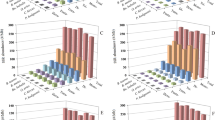Abstract
Some aspects of microsatellite evolution, such as the role of base substitutions, are far from being fully understood. To examine the significance of base substitutions underlying the evolution of microsatellites we explored the nature and the distribution of interruptions in dinucleotide repeats from the human genome. The frequencies that we inferred in the repetitive sequences were statistically different from the frequencies observed in other noncoding sequences. Additionally, we detected that the interruptions tended to be towards the ends of the microsatellites and 5′-3′ asymmetry. In all the estimates nucleotides forming the same repetitive motif seem to be affected by different base substitution rates in AC and AG. This tendency itself could generate patterning and similarity in flanking sequences and reconcile these phenomena with the high mutation rate found in flanking sequences without invoking convergent evolution. Nevertheless, our data suggest that there is a regional bias in the substitution pattern of microsatellites. The accumulation of random substitutions alone cannot explain the heterogeneity and the asymmetry of interruptions found in this study or the relative frequency of different compound microsatellites in the human genome. Therefore, we cannot rule out the possibility of a mutational bias leading to convergent or parallel evolution in flanking sequences.

Similar content being viewed by others
References
Armour JA, Harris PC, Jeffreys AJ (1993) Allelic diversity at minisatellite MS205 (D16S309): evidence for polarized variability. Hum Mol Genet 2:1137–1145
Arndt PF, Hwa T, Petrov DA (2005) Substantial regional variation in substitution rates in the human genome: importance of GC content, gene density, and telomere-specific effects. J Mol Evol 60:748–763
Brohede J, Ellegren H (1999) Microsatellite evolution: asymmetry of substitutions within repeats and neutrality of flanking sequences. Proc R Soc Lond B 266:825–833
Bull LN, Pabon-Pena CR, Freimer NB (1999) Compound microsatellite repeats: practical and theoretical features. Genome Res 9:830–838
Dib C, Faure S, Fizames C, Samson D, Drouot N, Vignal A, Millasseau P, Marc S, Hazan J, Seboun E, Lathrop M, Gyapay G, Morissette J, Weissenbach J (1996) A comprehensive genetic map of the human genome based on 5,264 microsatellites. Nature 380:152–154
Eichler EE, Kunst CB, Lugenbeel KA, Ryder OA, Davison D, Warren ST (1995) Evolution of the cryptic FMR1 CGG repeat. Nat Genet 11:301–307
Ellegren H (2000) Heterogeneous mutation processes in human microsatellite DNA sequences. Nat Genet 24:400–402
Gatchel JR, Zoghbi HY (2005) Diseases of unstable repeat expansion: mechanisms and common principles. Nat Genet 6:743–755
Goldstein DB, Schlötterer C (1998) Microsatellites: evolution and applications. Oxford University Press, New York
Goodman MF, Fygenson KD (1998) DNA polymerase fidelity: from genetics toward a biochemical understanding. Genetics 148:1475–1482
Harr B, Zangerl B, Schlotterer C (2000) Removal of microsatellite interruptions by DNA replication slippage: phylogenetic evidence from Drosophila. Mol Biol Evol 17:1001–1009
Jeffreys AJ, Tamaki K, MacLeod A, Monckton DG, Neil DL, Armour JA (1994) Complex gene conversion events in germline mutation at human minisatellites. Nat Genet 6:136–145
Jin L, Macaubas C, Hallmayer J, Kimura A, Mignot E (1996) Mutation rate varies among alleles at a microsatellite locus: phylogenetic evidence. Proc Natl Acad Sci USA 93:15285–15288
Kong A, Gudbjartsson DF, Sainz J, Jonsdottir GM, Gudjonsson SA, Richardsson B, Sigurdardottir S, Barnard J, Hallbeck B, Masson G, Shlien A, Palsson ST, Frigge ML, Thorgeirsson TE, Gulcher JR, Stefansson K (2002) A high-resolution recombination map of the human genome. Nat Genet 31:241–247
Kruglyak S, Durrett RT, Schug MD, Aquadro CF (1998) Equilibrium distributions of microsatellite repeat length resulting from a balance between slippage events and point mutations. Proc Natl Acad Sci USA 95:10774–10778
Li WH (1997) Molecular evolution. Sinauer Associates, Sunderland, MA
Marra G, Shar P (1999) Recognition of DNA alterations by the mismatch repair system. Biochem J 338:1–13
Schlötterer C, Amos B, Tautz D (1991) Conservation of polymorphic simple sequence loci in cetacean species. Nature 354:63–65
Smith NG, Webster MT, Ellegren H (2002) Deterministic mutation rate variation in the human genome. Genome Res 12:1350–1356
Stallings RL (1995) Conservation and evolution of (Ct)(N)/(Ga)(N) microsatellite sequences at orthologous positions in diverse mammalian genomes. Genomics 25:107–113
Stephan W, Kim Y (1998) Persistence of microsatellite arrays in finite populations. Mol Biol Evol 15:1332–1336
Tachida H, Iizuka M (1992) Persistence of repeated sequences that evolve by replication slippage. Genetics 131:471–478
Taylor JS, Durkin JM, Breden F (1999) The death of a microsatellite: a phylogenetic perspective on microsatellite interruptions. Mol Biol Evol 16:567–572
Vowles EJ, Amos W (2004) Evidence for widespread convergent evolution around human microsatellites. PLoS Biol. 2:E199
Weber JL, Wong C (1993) Mutation of human short tandem repeats. Hum Mol Genet 2:1123–1128
Webster MT, Hagberg J (2007) Is there evidence for convergent evolution around human microsatellites? Mol Biol Evol 24:1097–1100
Zhang Z, Gerstein M (2003) Patterns of nucleotide substitution, insertion and deletion in the human genome inferred from pseudogenes. Nucleic Acids Res 31:5338–5348
Zhu Y, Strassmann JE, Queller DC (2000) Insertions, substitutions, and the origin of microsatellites. Genet Res 76:227–236
Acknowledgments
We thank Dr. Gary Benson for his helpful comments on the use of his program Tandem Repeats Finder (TRF). This research was funded by a grant from Xunta de Galicia awarded to M.V.
Author information
Authors and Affiliations
Corresponding author
Rights and permissions
About this article
Cite this article
Varela, M.A., Sanmiguel, R., Gonzalez-Tizon, A. et al. Heterogeneous Nature and Distribution of Interruptions in Dinucleotides May Indicate the Existence of Biased Substitutions Underlying Microsatellite Evolution. J Mol Evol 66, 575–580 (2008). https://doi.org/10.1007/s00239-008-9107-3
Received:
Revised:
Accepted:
Published:
Issue Date:
DOI: https://doi.org/10.1007/s00239-008-9107-3




